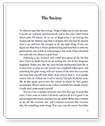Essay Instructions: History of the American Motion Picture
Length: 6-7 pages
Format: Double-spaced, 12-point font, 1” margins
Assignment:
Your task for the research paper is to focus on a decisive event, piece of technology, concept, or group of individuals that played a role in the development of American cinema prior to 1939. Please outline the specific origins and effects of your selected topic and clearly explain its historical significance by constructing an argument supported by a strong thesis and evidence.
Paper Topic Selection:
• Keep the length of the assignment in mind when you select your topic. Please try to avoid redundant topics such as D.W. Griffith’s role in the development of film narrative or Hollywood’s transition to sound that are much too broad and exhaustive for an assignment of this length. Instead, focus on a specific aspect from the course that interests you. This will help you construct an original, historically-grounded argument.
• Develop a research question that will in turn help you arrive at a solid thesis. You might begin with the topic about the conversion to sound film, but the research question should be more developed and specific. For example, “how did the conversion to sound film impact a major studio and its ‘house’ style?” Next, you should do some preliminary research in order to find a plausible answer grounded in historical data and evidence. Afterwards, you will be able to draft a thesis statement.
Paper Topic Suggestions:
• Write a general research paper using a minimum of three secondary sources analyzing a specific historical event in U.S. film history. For example, “how did the adaptation of synchronized sound technology impact independent animation from 1925 to 1935?”
• While not required, using archival documents and primary resources can help you formulate an original and stimulating research paper. The following suggestions are recommended topics for the advanced student.
1) Choose a film screened in class and write a historically-grounded reception study as to how the film was received by contemporary audiences in its original production context consulting film reviews from newspapers (The New York Times, The Los Angeles Times), trade journals (Variety, Motion Picture Herald, Box Office, Bioscope), and film magazines (Photoplay). These sources can be found in the Arts Library either in bound copies, microfilm, and/or Proquest article database. Please consult with your TA and the Arts library reference desk on how to locate these materials.
2) Using the Production Code Administration censorship files housed at the Margaret Herrick Motion Picture Academy Library, choose a film as a case study that demonstrates how the Hays office censored Hollywood films in the 1930s. This is a primary research project, so you will need to consult your TA about how to use archives and familiarize yourself with the Herrick library policies and plan ahead to access the materials ahead of the assignment due date.
Paper Guidelines and Requirements:
• Your paper must have a thesis. A thesis consists of a claim/argument, the techniques, concepts, general themes, theories, historical evidence, etc. that you choose to prove your claim, and the larger significance of your claim in terms of understanding your topic as a whole. Please bold the text of your thesis statement in your paper so that both you and your TA will recognize it.
• You must cite historical and scholarly evidence to support your argument and you are required to use a minimum of three sources for your research. Acceptable sources include scholarly books and articles published in scholarly journals, and/or primary sources (news papers and magazines from the original historical period). A wide selection of relevant source material has been placed on reserve for the class in the Arts Library, located in 1400 Public Policy. You should try to use books and articles published after 1985 in order to benefit from the extensive and recent innovations in the field of film history in the last twenty years. **Internet sites such as IMDB.com and Wikipedia are great for getting a general sense of information and should be cited accordingly. However, they do not count as part of your three required sources.**
• Do not write a summary history of your topic, recycle an argument from another author and/or book, or write a “great man/woman” biography if you choose to focus on individuals and their contribution to film history. For example, the following are unacceptable theses and topics:
A) “The conversion to sound film forever changed the movie industry.”
B) “D.W. Griffith was the greatest and most innovative filmmaker of his time or of any generation.”
C) “Walt Disney supplied the United States with a magical world of fantasy that has delighted children and adults alike.”
• All information and ideas adapted from another source, including direct quotations, must be properly cited with endnotes, footnotes, and/or parenthetical documentation. Please consult either the MLA handbook for Writers of Research Papers or The Chicago Manual of Style for correct citation procedures. You may use either MLA or Chicago style but please choose one and be consistent in your citations throughout the paper.
Topic: star systems and its contribution to the development of Hollywood PR and advertising stratgies.
How did star systems contribute the development of Hollywood PR and advertising system?
Examples of stars such as Theda Bara, Florence Lawrence etc...
How did it affect the film industry?
How is it relevent to today's Hollywood PR and advertising strategies?


